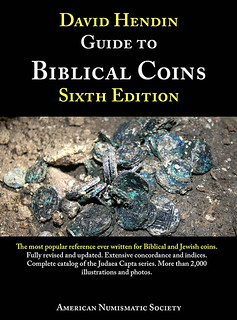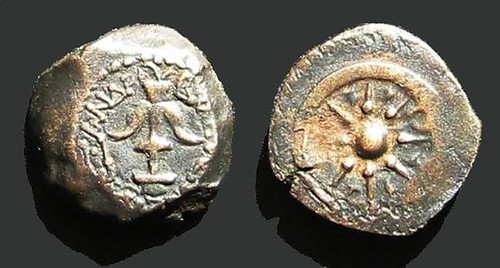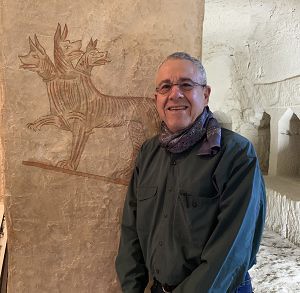
PREV ARTICLE
NEXT ARTICLE
FULL ISSUE
PREV FULL ISSUE
BOOK PREVIEW: GUIDE TO BIBLICAL COINS 6TH ED.A couple of readers forwarded this article by David Hendin. It's a preview of the upcoming new edition of his book on Biblical coinage. Thanks! We'll look forward to its publication. -Editor
Take for example the problem of dating coins; despite the fact that some coins actually come with dates, it is not always clear what those dates refer to. For example, in his 1881 Coins of the Jews, numismatist Frederick Madden attributed the silver coins inscribed The issue of dating gets predictably more difficult with earlier coinage. My friend and teacher, the late Ya'akov Meshorer (Chief Curator of Archaeology at the Israel Museum) correctly dated all of the Jewish War and Bar Kokhba Revolt coins in his 1967 Jewish Coins of the Second Temple Period. But Meshorer shook up the establishment by theorizing that Alexander Jannaeus (who reigned from 104-76 BCE) struck the first Hasmonean coins.
He further posited that Jannaeus issues were followed by coins struck by subsequent Hasmonean kings, Hyrcanus II, Aristobulus II, and Mattatayah Antigonus (the last king of the dynasty, executed by the Romans in 37 BCE after being captured and handed over by Herod, who had already been proclaimed But Meshorer's theory was quickly countered by Arie Kindler (of the Haaretz Museum and Tel Aviv University) who wrote in Coins of the Land of Israel in 1974 that the Hasmoneans struck coins in this order: Hyrcanus I, Aristobulus I, Jannaeus, Hyrcanus II, and Mattathias Antigonus. The problem is that coins with the name Yehochanan (or John) could refer to Hyrcanus I (135-104 BCE) or to his grandson Hyrcanus II who reigned some 40 years later. This meant uncertainty regarding sites or strata dated by such coins. In 1976 this writer entered the fray with the first edition of Guide to Ancient Jewish Coins. Like Kindler, I also highlighted the find of a coin struck by the Syrian king Antiochus VII in Jerusalem bearing both a date and a Judean symbol as a chronological anchor. But I still followed Meshorer's then current theory of Hasmonean coin chronology (only until my 3rd edition). The revisions continue. Guide to Ancient Jewish Coins was retitled Guide to Biblical Coins for subsequent editions 2nd (1987), 3rd (1996), 4th (2001), and 5th (2010). This fall the 6th edition will be published by the American Numismatic Society (ANS). I am happy to have gifted all rights and revenues for this book to the ANS. Over the decades I have updated my book to include the most recent research, including from over 75 papers I have written or co-written with colleagues. My archaeological fieldwork at Sepphoris with Duke University and Hebrew University dramatically enhanced knowledge, as have my site visits to hundreds of locations in Israel, the Palestinian Territories, Jordan, Egypt, and Lebanon with friends and colleagues. In addition to adding new types, removing incorrectly attributed coins, and refining chronology (seriation) of the coins, I have also added new topics of interest. For example, in the 4th edition I added a section covering and listing coins countermarked by the Roman legions stationed in the ancient Holy Land. In the 5th edition I added text and an extensive catalog of the Judaea Capta coins, issued by the Emperor Vespasian to celebrate his son Titus' destruction of the Second Temple in 70 CE.
Numismatics is an important ancillary field to archaeology, anthropology, history, mathematics, and economics. Yet few universities worldwide offer numismatic tracks. Top academic numismatists may be professors, but they are often diplomats, attorneys, doctors, businessmen, writers, clergymen, or even coin dealers. As noted by Frank L. Holt in his engaging When Money Talks: A History of Coins and Numismatics, the scholarly societies that publish the journals
The goal of Guide to Biblical Coins has been to inform scholars and collectors who seek an overview of the coins of the Second Temple Period, which also played a critical role in the formation and evolution of Christianity. This work will continue.
To read the complete article, see:

Wayne Homren, Editor The Numismatic Bibliomania Society is a non-profit organization promoting numismatic literature. See our web site at coinbooks.org. To submit items for publication in The E-Sylum, write to the Editor at this address: whomren@gmail.com To subscribe go to: https://my.binhost.com/lists/listinfo/esylum All Rights Reserved. NBS Home Page Contact the NBS webmaster 
|


